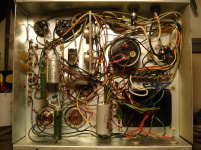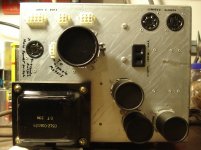Question from a noob... attached are pictures of a solid state baldwin organ amp. Could anybody help me figure out where to attach the guitar input, speaker output, and main volume control? This is my 2nd organ->guitar amp conversion... but I was stupid this time, and didn't trace the wires to their ultimate purpose. thanks!
Attachments
That's not solid state.
And it was a mistake to not figure out the connections when you removed it.
And it was a mistake to not figure out the connections when you removed it.
What do you mean "not solid state"? I see no tubes, and I do see transistors in the interior photo.
I agree - it was a mistake... but maybe I could systematically check the different wires leading into the round & rectangular sockets. Guess and check is sometimes a viable option. Fast Eddie, if it's not solid-state, what type is it? Thanks for the help.
What do you mean "not solid state"? I see no tubes, and I do see transistors in the interior photo.
I see point to point wiring. It's old, old school; not that there's anything wrong with that.
Last edited:
I agree - it was a mistake... but maybe I could systematically check the different wires leading into the round & rectangular sockets. Guess and check is sometimes a viable option. Fast Eddie, if it's not solid-state, what type is it? Thanks for the help.
I would like to help you, but it's nigh on impossible to do it from the photo. I do wish you luck though.
You wouldn't be the first person to convert an organ amp to a guitar amp. It's a pretty good idea. 🙂
the round sockets are actually the female receivers for cables that would connect to external tone cabinets (speakers). The 5 pin socket on the right was used to connect the power switch and tremolo controls. The 6 and 7 pin sockets were not being used in the organ when I picked it up. Thanks for any and all comments!
If remote cabinets mean speakers, then that's a no brainer. Look for a wire that comes off a big electrolytic cap, and goes back to the power transistors. Speaker from there to ground is a good bet.
The input side is somewhere over on the left. I see three small signal stages. Look for a blocking cap (probably ceramic) that connects to the base of one of the transistors, and then goes off to some connector. Try putting your signal in there and see what happens. For a volume control, just put a pot between there and your signal. I also see an electrolyic (lower left) that's leaking and should be replaced before trying anything.
The input side is somewhere over on the left. I see three small signal stages. Look for a blocking cap (probably ceramic) that connects to the base of one of the transistors, and then goes off to some connector. Try putting your signal in there and see what happens. For a volume control, just put a pot between there and your signal. I also see an electrolyic (lower left) that's leaking and should be replaced before trying anything.
another realization... the manual for the Baldwin organ says that the organ has 3 separate transistor amps... so, I found 3 smaller transformers (output transformers?) in the upper section of the organ (each with it's own potentiometer). Could the designers have made this one power amp section and then linked up to the output amp section? Is it possible that the amp shown in the pictures won't really work without at least one of those transformers? If that's the case, then I'm in over my head, and I might just scrap the thing for parts, buy a partial kit, and start from scratch (with idiot-proof instructions!)
Without a schematic, you'll need experience to recognize the old parts and build up a picture of the circuits and their operation. It's possible that schematics of similar organs of the period would help understanding but you still need to learn the components, their ratings, functions and how to safely make the whole thing operational and carry out the mods to adapt it to guitar use.
Unless you are committed to this amplifier, a fully documented DIY module or kit designed for guitar use will be a lot easier intro and probably result in a more useful amplifier if optioned to suit your needs. Avoid the many cheap kits that just give you an amplifier PCB with some terminals but no explanation or suggestions for all the other stuff you also need to make it work.
As a noob, you'll need to learn about guitar amps, their functional circuit blocks, schematics, components etc. and a book with a plan to teach systematically is a lot more useful overall than one-liner advice over the net. Hopefully a brochure or doc. with a good kit will help a little too.
Unless you are committed to this amplifier, a fully documented DIY module or kit designed for guitar use will be a lot easier intro and probably result in a more useful amplifier if optioned to suit your needs. Avoid the many cheap kits that just give you an amplifier PCB with some terminals but no explanation or suggestions for all the other stuff you also need to make it work.
As a noob, you'll need to learn about guitar amps, their functional circuit blocks, schematics, components etc. and a book with a plan to teach systematically is a lot more useful overall than one-liner advice over the net. Hopefully a brochure or doc. with a good kit will help a little too.
Ah. Solid state refers to semiconductor circuits as opposed to tubes. The wiring style can be anything.
Not sure, but I am not yet convinced this unit even is an amplifier, it could be a power supply, and the transistors are there as regulators. I don;t see any signal connectors. And organ tone cabinets were often, if not usually, powered cabs.
Not sure, but I am not yet convinced this unit even is an amplifier, it could be a power supply, and the transistors are there as regulators. I don;t see any signal connectors. And organ tone cabinets were often, if not usually, powered cabs.
Ian Finch, thanks for the brutal honesty... and you're right; it makes more sense to start fresh with a diy kit. My problem is that I had some success previously turning an old Hammond Cadette into a guitar amp. The big difference was that that amp was SO simple, and it already included an aux. input that worked for guitar. I didn't have to do anything to the amp itself - i merely took everything out, built a new cabinet (using the plywood from the junk organ), and re-installed everything. It sounds decent, looks cool, and is a nice conversation piece.... but I didn't really learn anything.
Enzo, after trying for many hours to force this thing into being an audio amplifier, I think you're right - something's missing, and I don't have the knowledge to figure it out. Maybe I can repurpose the chassis, transformers, pots, switches, etc. and buy a kit... any good websites to visit? How about ax84.com?
thank you all for your comments.
Enzo, after trying for many hours to force this thing into being an audio amplifier, I think you're right - something's missing, and I don't have the knowledge to figure it out. Maybe I can repurpose the chassis, transformers, pots, switches, etc. and buy a kit... any good websites to visit? How about ax84.com?
thank you all for your comments.
If the thing can be safely powered up, you can find out what voltages the power transformers make. AX84 is a fine place, but it is about tube amps, and so if your unit is making 35v supplies, then it won;t be of much use for tube circuits.
In your interior view, that lower left can cap is leaking its little guts out, so I might not expect much from the caps in the unit.
In your interior view, that lower left can cap is leaking its little guts out, so I might not expect much from the caps in the unit.
- Status
- Not open for further replies.
- Home
- Live Sound
- Instruments and Amps
- solid state organ amp conversion to guitar

